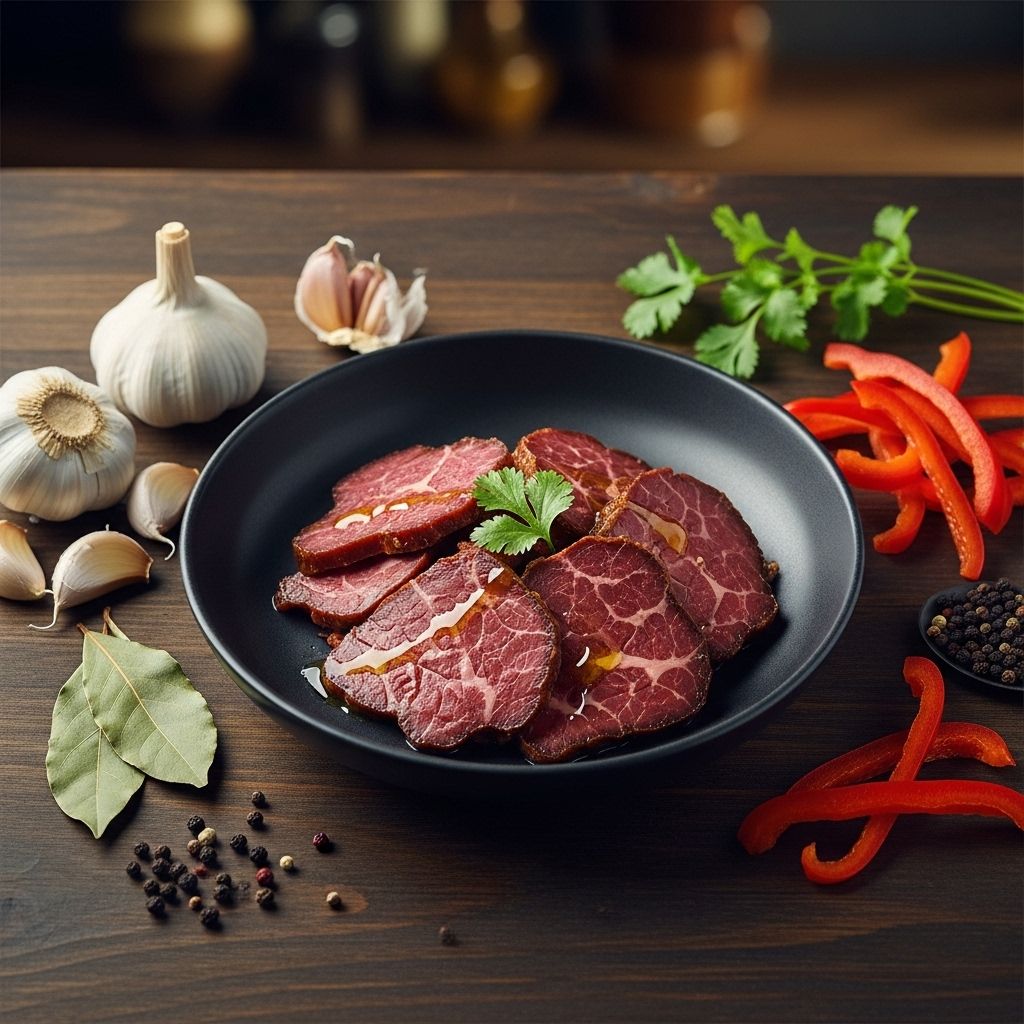How to Make Cuban Tasajo: Cured Beef, Island-Style
Savor tender strips stewed in a tomato-and-spice sofrito for island-inspired flavor.

Tasajo is more than just a cured beef dish in Cuba—it carries the story of an island, reflecting centuries-old preservation techniques, resilience, and powerful flavors. The artful transformation of tough beef cuts into tender, aromatic morsels steeped in a tomato-based sofrito is emblematic of Cuban ingenuity in the kitchen. Here, we’ll explore the historical roots of tasajo, its adaptation on the island, and provide a detailed, step-by-step guide to making this beloved Cuban staple at home.
What Is Tasajo?
Tasajo is a traditional dish consisting of beef that has been preserved through heavy salting and drying (originally in the sun, but often air-dried or lightly smoked today). The salt cure transforms tough beef into meat that can last for months without refrigeration—a necessity in the days before modern preservation. In Cuba, tasajo is often stewed with a flavorful combination of tomatoes, peppers, onions, and signature spices to rehydrate the meat and infuse it with a rich, savory aroma.
A Brief History of Tasajo
The roots of tasajo stretch back to Spanish and African culinary traditions, where meat preservation was key to survival. In Spain, “tasajo” referred to air- or sun-dried beef, and similar techniques traveled with colonists and enslaved Africans to the Caribbean. Over time, Cuban cooks adapted this method, relying on salt and sun to stretch meager protein supplies in the tropical climate. What emerged is a dish with deep connections to the island’s history of innovation amidst scarcity. Tasajo also holds cultural significance in Cuba as a symbol of persistence and flavor born from necessity.
Choosing the Right Meat
Traditionally, tasajo is made from tough, lean cuts with lots of connective tissue, such as beef flank, skirt steak, or beef shank. These cuts benefit from the salting and slow stewing process, which breaks down fibers and transforms them into tender, flavorful morsels. When selecting meat for tasajo:
- Choose cuts with visible muscle grain and minimal fat marbling.
- If possible, use freshly butchered beef for the optimal texture; otherwise, any tough, lean cut will suffice.
- If beef isn’t available, some variations use horse or venison—though these are rare today.
Curing the Beef: The Tasajo Technique
The hallmark of tasajo is its curing process, which imparts distinctive texture and flavor. Here’s how to prepare your beef:
- Slice the Beef: Cut your beef into thin strips, no thicker than 1/2 inch. Thinner pieces cure more evenly and rehydrate better.
- Salt Generously: Coat each piece in kosher salt or coarse sea salt, massaging it into the fibers. Be liberal—this is both for flavor and preservation.
- Optional Seasonings: Some cooks add a sprinkle of cracked black pepper, ground allspice, or bay leaves.
- Drain and Cure: Lay the salted beef on a wire rack set over a tray in the refrigerator, or in a cool, well-ventilated place. Leave uncovered for 3 to 5 days, draining any released liquid daily.
- Inspect: The beef is ready when it’s firm, stiff, and deeply colored. It should smell slightly savory, not unpleasant.
- Store: Tasajo can now be wrapped tightly and refrigerated for up to a month. For longer storage, freeze.
Rehydrating and Cooking Tasajo
Before it can be enjoyed, tasajo must be soaked and stewed to bring it back to life. Here’s how Cubans transform this humble cured beef into a succulent, satisfying meal:
Soaking the Beef
- Rinse: Wash the cured beef pieces under cold running water to remove excess salt.
- Soak: Place in a large bowl, cover with ample cold water, and refrigerate for 12–24 hours, changing the water every few hours. This step is essential to desalinate and soften the meat.
Simmering and Stewing
- Boil: Drain the soaked beef, then cover with fresh water in a heavy pot. Bring to a gentle boil and simmer for about 1 hour, or until the meat begins to soften.
- Shred: Once tender, remove beef, let cool slightly, and shred by hand or with forks into bite-sized pieces.
- Sauté the Sofrito: In a large skillet, heat olive oil. Add chopped onions, bell peppers, and garlic, cooking until softened and fragrant.
- Tomato and Spices: Stir in tomato sauce, diced tomatoes, ground cumin, oregano, bay leaf, and a pinch of ground black pepper. Sauté for a few minutes until well-combined.
- Combine and Stew: Add the shredded beef to the sofrito, toss to coat, and pour in a splash of beef stock or water if needed. Simmer gently for 30 minutes, allowing flavors to meld and the beef to become meltingly tender.
Cuban Tasajo Ingredients
- 2 pounds beef flank, skirt steak, or shank (cut into strips)
- 1/2 cup kosher salt (for curing)
- 2 tablespoons olive oil
- 1 large onion, finely chopped
- 1 green bell pepper, diced
- 4 cloves garlic, minced
- 1 (15-ounce) can tomato sauce
- 1 (14-ounce) can diced tomatoes
- 2 teaspoons ground cumin
- 2 teaspoons dried oregano
- 2 bay leaves
- Salt and pepper to taste
- 1 cup beef stock (or water)
Cuban Tasajo Recipe: Step by Step
- Cure the Beef:
- Slice beef into 1/2-inch strips.
- Rub generously with kosher salt, cover, and refrigerate for 3–5 days. Drain any liquid daily.
- Desalt and Soak:
- Rinse salt from beef under cold water.
- Soak in fresh water, changing the water every few hours, for 24 hours.
- Boil to Tenderize:
- Boil beef in a large pot of water for about 1 hour until tender. Drain and cool.
- Shred the Beef:
- When cool enough to handle, shred the beef by hand or with forks.
- Prepare the Sofrito:
- Heat olive oil in a large skillet. Sauté onions, bell peppers, and garlic until soft.
- Add Tomatoes and Spices:
- Add tomato sauce, diced tomatoes, cumin, oregano, bay leaves, and black pepper. Simmer for 5 minutes.
- Add Beef and Simmer:
- Toss the shredded beef with the sofrito and pour in beef stock or water.
- Simmer gently, uncovered, for 30 minutes, stirring often and adjusting seasoning as needed.
- Serve:
- Enjoy hot, usually accompanied by white rice, black beans, or fried plantains.
Classic Cuban Tasajo Serving Suggestions
- With Congrí or Moros y Cristianos: Pair tasajo with rice and black beans for a classic Cuban meal.
- Fried Plantains: Maduros or tostones complement the savory beef.
- Boiled or Roasted Yuca: The starchy root offers a delightful contrast to the saucy meat.
- Pickled Onions or Green Salad: Add tang and freshness to balance rich flavors.
Cooking Tips and Variations
- Use the Right Amount of Salt: Be generous when curing, but always soak thoroughly to remove excess salt before cooking.
- Try Other Proteins: Though beef is traditional, pork or goat tasajo is made in some Cuban regions.
- Add Vegetables: Some variations incorporate potatoes or squash to stretch the stew.
- Adjust Seasonings: Cumin, bay leaf, oregano, and black pepper are essential—feel free to add a dash of smoked paprika for depth.
- Use Homemade Sofrito: Prepare your own sofrito base for an even more authentic flavor.
Storing and Reheating Tasajo
Like many slow-cooked stews, tasajo improves with age. Store leftovers in an airtight container in the refrigerator for up to 5 days, or freeze for longer storage. Reheat gently in a covered saucepan over low heat, adding a splash of stock or water to prevent drying.
Frequently Asked Questions (FAQs)
Q: Can I use pre-salted or dried beef to make Cuban tasajo?
A: Yes, pre-salted beef (such as salt-cured beef sold in Latin American groceries) can be used. Rinse thoroughly, soak to remove excess salt, and follow the rest of the recipe.
Q: How salty is tasajo supposed to be?
A: Proper soaking and boiling remove most excess salt, leaving tasajo well-seasoned but not overwhelmingly salty. Always taste during simmering and adjust as needed.
Q: Is tasajo spicy?
A: Cuban tasajo is not spicy-hot, but deeply savory and fragrant thanks to cumin, oregano, and aromatic vegetables.
Q: Can I make tasajo in advance?
A: Absolutely! The flavors deepen after a day or two in the fridge, so tasajo is ideal for making ahead.
Q: Can tasajo be made with other meats?
A: While beef is most traditional, pork, goat, or game meats can be substituted (using the same curing, soaking, and stewing process).
Conclusion: The Enduring Legacy of Tasajo
Tasajo is more than a meal—it’s a journey through Cuban resilience and culinary invention. This salt-cured, slow-stewed beef highlights the creativity born from necessity, carrying the essence of old Havana and Cuba’s countryside into every savory bite. As you prepare and savor tasajo, you participate in a centuries-old tradition, preserving more than just meat but also a taste of a vibrant, resourceful culture. Buen provecho!
References
Read full bio of Sneha Tete












